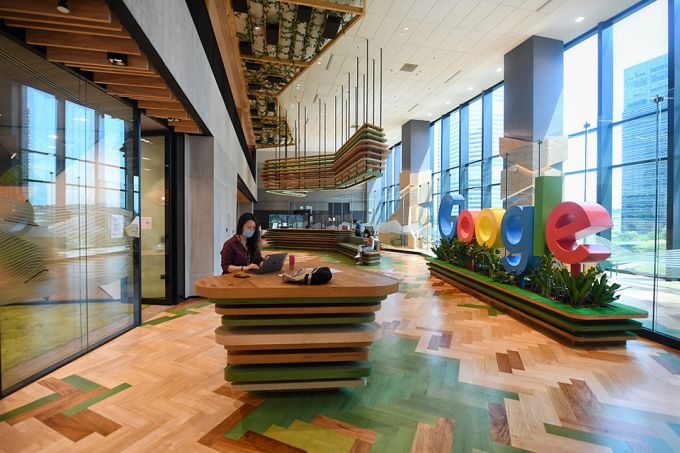A new age for office space: What happens to the office market when offices adapt?

WITH remote working high on the agenda and businesses looking to cut costs, early doomsayers had proclaimed a grim post-pandemic future for offices and their landlords.
Yet a recent survey of firms in the Asia-Pacific by CBRE showed that about two-thirds of those polled now plan to eventually limit remote working to one or two days weekly.
And the latest data showed that office rents rose in the first quarter of this year. According to the Urban Redevelopment Authority (URA), rents of office space in Singapore's central region rose 3.3 per cent quarter on quarter in Q1 2021, reversing from a 3.5 per cent contraction in the fourth quarter of last year.
Still, the URA data also showed that prices of office space in the central region contracted 2.7 per cent in Q1 2021, after a 3.1 per cent decrease in Q4 2020.
The island-wide vacancy rate for office space edged up to 11.9 per cent at the end of Q1 2021, from 11.8 per cent at the end of the previous quarter.
Real estate consultancy JLL estimates that islandwide, there is about 900,000 square feet (sq ft) of business space that occupiers are looking to release. These occupiers hail from various sectors, including those which have been crippled by the global pandemic such as hospitality and travel.
At 900,000 sq ft, this is under 1.5 per cent of islandwide office stock, albeit sharply higher than the approximately 150,000 sq ft that occupiers are typically looking to dispose of in any given market.
CBRE's co-head of office services, David McKellar, says: "Firms have begun to turn focus towards accommodating some flexible working alternatives in the longer term. Based on the same CBRE survey, more firms have indicated a shift in attitude towards acceptance of remote working as an option for the workforce as compared to pre-Covid-19."
Savills executive director (research & consultancy) Alan Cheong expects that most companies will likely trim some of their office footprint, at least for the medium term.
He says: "For Singapore, it is likely to contract more out of the concern that business conditions will be more challenging and, given the already tried and tested mode of work from home (WFH), companies will attempt to pare overheads by shedding some office space and/or moving to either secondary locations or WFH."
Savills estimates that close to 25 per cent of leases for CBD Grade A office buildings are poised for renewal this year, while nearly 16 per cent are due in 2022. But even as some firms choose to right-size their real estate, others may defer this decision by opting to renew leases on a short-term basis.
"The process of right sizing should continue until 2022, before the process tapers and the level of uncertainty eases," Mr Cheong says, adding that landlords could choose to renovate or redevelop their buildings during these two years to reposition their assets.
Remote working, rightsizing, shedding space
Companies such as tech giants Google and Facebook have moved towards more remote working, while banks have started to shed space.
In an email to Google employees on May 5, chief executive Sundar Pichai announced that the company plans to introduce more flexibility in the workplace, including a hybrid work week where employees spend three days in the office, the ability to work at more of Google's global offices, up to four "work-from-anywhere" weeks annually, as well as opportunities for 100 per cent remote working.
However, the ability to work from another global office may depend on job roles, while employees who opt for complete remote working may see their compensation adjusted.
In Singapore, Google occupies several floors across three blocks at Mapletree Business City, in addition to two data centres in Jurong with a third in the works. It has some 2,000 employees here.
Rachel Burton, human resources director (Apac) at Facebook, tells The Business Times (BT) that the social media giant has given staff the option to work from home until July 2. After that, the office will reopen at 50 per cent capacity, subject to government regulations. Employees who are not full-time remote workers may continue working from home until early August.
Facebook and Google did not comment on whether they have plans to rationalise office space in Singapore.
Some consultants say they expect more companies to adopt hybrid working as a means to attract and retain talent. This should bolster demand for co-working spaces as the flexible lease terms enable them to scale up - or down - in line with needs. For instance, a Bloomberg report last October said Chinese tech giant Tencent has leased nearly 200 desks at co-working outfit JustCo at OCBC Centre East.
Even prior to the pandemic, banks were already rationalising excess space due to offshoring, the decentralisation of back office functions, as well as a general reduction in headcount, CBRE's Mr McKellar said.
Cushman & Wakefield estimates that at least 500,000 sq ft of office space in the central area may be released by banks as secondary or shadow space over the next two years.
Citigroup has given up about 100,000 sq ft of space over three floors at Asia Square Tower 1, while DBS is said to be reducing its footprint at Tower 3 of Marina Bay Financial Centre (MBFC) by 75,000 sq ft. E-commerce giant Amazon has reportedly leased three floors of space at Asia Square Tower 1, space that was vacated by Citi. Amazon declined to comment on BT's queries.
Other banks said to be scaling back space include Mizuho at Asia Square Tower 2, where it is letting go of 16 per cent of its space, and ANZ at Ocean Financial Centre.
Joel Fastenberg, Citi's head of human resources (Asean and Singapore), says: "While some critical operations staff are required to work from the office, we recognise that our staff have benefitted from aspects of working remotely, and we intend to create additional flexibility going forward."
Prior to the latest tightening of measures, about a third of its 8,500 employee base were going into the office. Meanwhile, its consumer banking business here has been testing out a pilot programme since March this year, where employees can WFH one to four days per week, depending on their job scope. It has also tweaked the design of its office at Changi Business Park to offer different meeting areas.
Aside from some 200,000 sq ft of space at Asia Square, Citi has 11 properties in Singapore in all, including 400,000 sq ft at Changi Business Park and a 15,000 sq ft back office at Orchard.
Meanwhile, DBS has said that it is planning to cut its office footprint by about 20 per cent over the next five to six years.
Erwin Chong, group head of corporate real estate at DBS, says the bank has initiated new ways of working since the start of the year, including "permanent hybrid work arrangements, with employees given the option to work remotely up to 40 per cent of the time, and flexible work policies such as a formal job-sharing scheme".
And in November last year, United Overseas Bank (UOB) announced a two-day-a-week remote work model which will be implemented once Covid-19 restrictions are lifted for its 26,000 employees.
"When the remote work policy has been fully rolled out in the future, we expect this will cover (about) 65 per cent of the roles at UOB," says Dean Tong, UOB's head of group human resources.
UOB is converting office space to open office layouts and collaborative work facilities such as conference rooms.
"We expect our net office space requirements to reduce, but not significantly," adds Mr Tong.
Similarly, OCBC has adopted a hybrid model of working from home and in the office. However, at its most recent earnings briefing, OCBC group chief executive Helen Wong said it has not cut back on space in Singapore, where it owns its own buildings.
The bank continues to review its branches, and has not ruled out further reduction in its branch network.
New demand stepping in
But even as some companies have given up space, other occupiers seeking a flight to quality have seized the opportunity to step in.
Mr McKellar says: "In 2020, 36.1 per cent of leasing volume was contributed by the technology sector, of which Chinese tech firms have been a feature, illustrated through the activities of firms such as Bytedance, Alibaba Group (through its subsidiary Lazada) and Tencent."
He adds: "Leasing activity continued to gain momentum in the first three months of 2021, with demand stemming from the technology and non-bank financial services industries such as asset management firms and, to a lesser extent, family offices."
JLL Singapore's head of research and consultancy Tay Huey Ying reckons that tech firms, drawn to the business environment here, talent pool, and easy access to funding, will support demand for office space this year, soaking up some of the space that banks and other companies are releasing.
"To top it all off, the Singapore government is proactively attracting technology firms to invest and grow here to further strengthen its tech hub status," she says.
Vijay Natarajan, analyst at RHB Group, notes that the office real estate investment trusts (Reits) have grown more optimistic as leasing momentum has picked up.
Keppel Reit, for instance, recorded positive rental reversions of 10.7 per cent for Q1 2021 as it signed leases for around 310,000 sq ft of space. However, its occupancy dipped to 96.5 per cent as at March 31, 2021, slightly lower from 98.9 per cent one year prior.
Mr Natarajan reckons that the resurgence in Covid-19 cases is a setback for the recovery in the overall office market, but does not expect significant impact for the long-term.
"What this could mean is that leasing momentum could slow down," he adds. "Companies from overseas looking to expand here might need to hit pause as the travel corridors are shut. There are going to be speed bumps, but the outlook remains slightly positive for the office market in the mid-term."
RHB is positive on Suntec Reit on the back of attractive valuations and earnings contributions from completed projects such as 9 Penang Road.
According to its Q1 2021 business update, Capitaland Integrated Commercial Trust's (CICT) occupancy for its Singapore office assets stood at 94.8 per cent, while its average office rents (as at Mar 31, 2021) worked out to S$10.28 per square foot (psf).
Where rents are at
Where rents are concerned, the downward pressure could be somewhat cushioned by the limited supply in the pipeline for 2021 and 2022, Savills' Mr Cheong reckons.
The halt in construction activities last year from Singapore's circuit breaker, coupled with any fall-out from the pandemic this year, could hamper construction timelines.
Savills expects CBD Grade A office rents to decline 5 per cent year on year in 2021, but does not entirely rule out office rents edging upwards either. The latter comes on the back of ageing office buildings being removed from the market for redevelopment or renovation, and as firms from the new economy fuel demand.
Data from JLL shows that among investment grade offices in the central business district (CBD), the average monthly gross effective rent retreated slightly by 0.3 per cent quarter on quarter to S$9.78 psf in Q1 2021, versus S$9.81 psf in Q4 2020. The vacancy rate for the basket of investment grade offices in the CBD tracked by JLL held steady at 6.8 per cent in Q1 2021, flat from Q4 2020 but slightly higher than the 5.6 per cent seen in Q1 2020.
Still, the rent correction in Q1 has moderated from the -2.6 per cent to -3.8 per cent range that was seen in the preceding three quarters, points out JLL's Ms Tay, citing an improving economy and ongoing vaccination efforts as among the factors giving market confidence a lift.
She expects CBD investment grade office rents could stabilise and possibly even see a modest recovery in the second half of 2021, on the back of firmer demand and a pick-up in market sentiment, barring unforeseen external shocks or setbacks in containing the pandemic.
Meanwhile, for the Grade A (core CBD) market tracked by CBRE, rents were flat quarter on quarter at S$10.40 psf in Q1 2021, albeit nearly 10 per cent lower year on year, while the vacancy rate eased from 3.9 per cent in Q4 2020 to 3.3 per cent.
On the supply side, JLL projects that nearly one million sq ft of new investment grade offices will come onstream in the CBD this year, up 14 per cent year on year, from buildings such as the refurbished 21 Collyer Quay, Afro-Asia and CapitaSpring.
Ms Tay notes that over 60 per cent of the supply slated to come onstream has already been pre-committed, with further take-up likely by the end of the year.
She adds: "We do not foresee any oversupply risk in the CBD investment grade office market in light of firming demand on the back of the recovery in Singapore's economy and occupier confidence, coupled with demand from tenants displaced from assets heading for redevelopment."
Outlook
In 2020, 0.56 million sq ft more office space was vacated than taken up in Singapore's islandwide office market, said CBRE. This negative net absorption marks the first time the net absorption number has turned negative since 2015.
However, things turned a corner in Q1 2021, with positive net absorption of 0.13 million sq ft, coming on the heels of three quarters of contraction.
Tight supply, especially within the CBD, will help to support the recovery, while some property developers could take this opportunity to capitalise on the government's CBD Incentive Scheme and the Strategic Development Incentive Scheme to give older buildings a facelift. This in turn will end up removing some stock from the market.
JLL's Ms Tay, who expects positive net absorption for 2021 as a whole, points to ongoing vaccination efforts and the recovering economy. These factors should "bolster market confidence and encourage expansion, while slowing downsizing and attrition plans", she says.
Mr McKellar adds: "At the same time, occupier activity is further supported by the displacement of tenants from buildings scheduled for redevelopment."
He says that supply in the office market is modest for the next four years at an average of 1.27 million sq ft annually - or about 24 per cent lower than the historical 10-year annual average volume of new-supply.
Mr McKellar expects that the flight to quality will give rise to a two-tier market between Grade A and Grade B office buildings, which means that the recovery will not lift all boats - at least, not equally.
Grade A office buildings are seen as benefiting the most as firms lock in leases amid softer rents. Taken together with the reduced Grade A pipeline supply, CBRE expects a modest growth in office rents this year.
Savills' Mr Cheong offers a slightly different perspective. As firms shift to smaller office sizes, this may push up rents for buildings with floor plates or unit sizes that fall smack within the "sweet spot" of 500 to 1,000 square metres, he suggests.
"While rents for the lower grade of offices may be more affected today, moving forward, the move to smaller office space may bring these office buildings back in vogue," he concludes.




